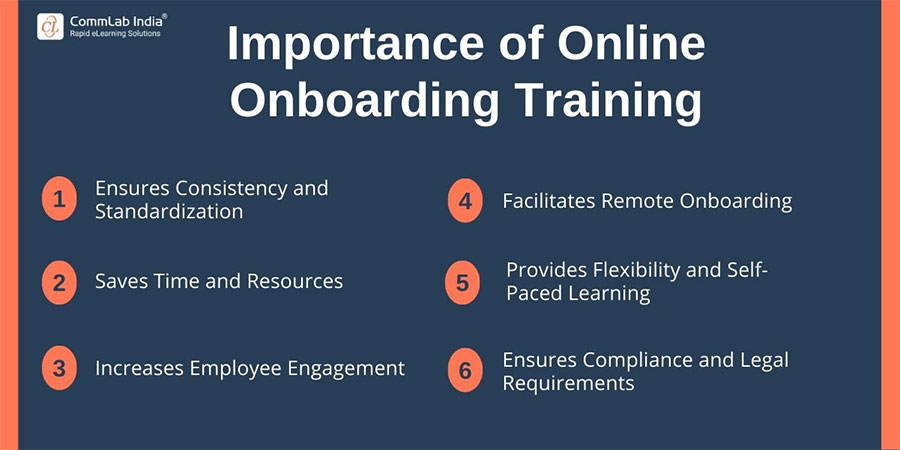7 Essential Tips for a Successful Online Onboarding Training

Are you ready to take your onboarding training program to the next level? In today's digital age, online onboarding has become an essential tool for companies looking to efficiently and effectively integrate new employees into their teams. But with so many options available, how do you ensure that your online onboarding training is successful? Here's an insightful source to rescue!
Backed by expert insights and industry trends, we bring to you a comprehensive list of 7 essential tips that will help you create a seamless and engaging experience for your new hires. From designing interactive modules to fostering a sense of community, these tips are guaranteed to make your online onboarding training program stand out from the rest.
Online Onboarding Training: Way to Transform New Beginnings
Online onboarding training epitomizes the virtual evolution of traditional in-person onboarding processes. It involves training new hires about the company's culture, policies, procedures, and job requirements through digital platforms like learning management systems, video conferencing tools, or email.
Online onboarding training offers unparalleled flexibility, enabling employees to complete their training remotely, anytime, and anywhere with an internet connection. The cost-effectiveness and scalability of online onboarding make it a preferred choice for organizations navigating the complexities of the modern work landscape.
Importance of Online Onboarding Training

1. Ensures Consistency and Standardization
Online onboarding eliminates variations in training quality by delivering standardized information, materials, and assessment criteria to all employees. This uniformity guarantees a consistent experience for everyone, a significant advantage over traditional in-person onboarding.
2. Saves Time and Resources
The efficiency of online onboarding extends to time and resource savings. Unlike traditional methods with scheduling complexities and associated costs, online onboarding provides on-demand access to crucial information, minimizing logistical challenges.
3. Increases Employee Engagement
Active engagement during onboarding significantly impacts long-term productivity and job satisfaction. Online onboarding achieves this by creating an interactive learning environment with multimedia content such as video-based learning, quizzes, and games, ensuring a positive and engaging experience for new employees.
Here are 5 effective strategies to increase engagement in online training:
4. Facilitates Remote Onboarding
The rise of remote work necessitates adaptable onboarding solutions. Online onboarding seamlessly integrates remote employees, overcoming geographical constraints and streamlining the onboarding process for a dispersed workforce.
5. Provides Flexibility and Self-Paced Learning
The flexibility of online onboarding allows employees to complete training at their own pace within a designated timeframe. This accommodates various learning styles and enables employees to revisit information, fostering a self-paced and effective learning environment.
6. Ensures Compliance and Legal Requirements
Online onboarding aids organizations in meeting compliance and legal requirements by providing essential information and documentation related to company policies, procedures, and regulations. This standardized approach reduces the risk of non-compliance issues.
→ Access Now: New Hire Onboarding Training for a Global Biopharma Major [Success Story]
Tips for a Successful Online Onboarding Training Program
Tip 1: Define Clear Goals and Objectives
The cornerstone of a successful online onboarding training program lies in clearly defined goals and objectives. Understanding your organization's needs, identifying specific learning outcomes, and involving key stakeholders such as HR professionals, managers, and subject matter experts ensure a purposeful and targeted training experience.
Tip 2: Create Engaging Content
Engaging content is the lifeblood of successful online onboarding. Tailor content to your audience by understanding their roles, expertise levels, and learning preferences. Keep it concise, leverage multimedia elements, and make it interactive with quizzes, games, and real-life examples to capture and maintain participant interest.

Tip 3: Utilize Interactive Tools and Activities
Keeping participants engaged in the virtual realm requires interactive tools and activities. Use polls, surveys, quizzes, and group discussions to foster engagement. Incorporate virtual whiteboards for collaboration and create a gamified learning experience with points, badges, and leaderboards.
Tip 4: Create Bite-Sized Microlearning Modules
Recognizing diverse learning needs, break down the training content into bite-sized microlearning modules. Start with an overview, keep each module focused on one topic, use multimedia, and include real-life examples to enhance understanding. Short, concise modules ensure participants can easily digest and retain information.
Tip 5: Provide Continuous Support and Feedback
Effective onboarding extends beyond training completion. Assign mentors, create an online resource library, and offer ongoing support to ensure new employees feel confident and equipped. Regular check-ins with managers, self-assessment opportunities, and interactive quizzes with constructive feedback contribute to a supportive onboarding journey.
Tip 6: Encourage Active Participation from Learners
Active participation is the heartbeat of successful online onboarding. Employ various forms of interaction, leverage multimedia, encourage questions and discussions, facilitate group work, and gamify the learning experience. Cater to different learning styles by using a variety of formats to maintain participant engagement.
Tip 7: Evaluate the Effectiveness of the Training Program
Evaluation is integral to refining and enhancing your online onboarding training program. Set clear learning outcomes, employ diverse online learning assessment methods, gather participant feedback, and continually assess the program's effectiveness. This iterative process ensures the ongoing improvement of your onboarding training initiatives.
Summing Up
In today's dynamic digital landscape, a well-executed online onboarding training program is indispensable for ensuring a seamless transition for new employees. By adhering to these 7 essential tips, organizations can optimize their virtual onboarding process, saving time, resources, and ensuring the success of new hires from day one. Constantly evaluate and refine your training based on feedback, keeping pace with evolving technology to make the most of your virtual onboarding initiatives. With a comprehensive and well-designed program, organizations can set their new employees on a trajectory for long-term success.
Read on our case study on interactive onboarding training to know more about the impact and effectiveness.





